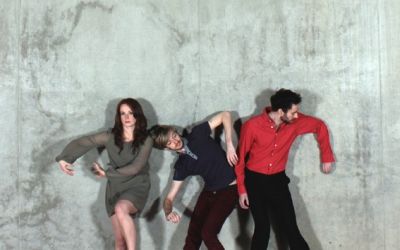
19.02.2013 | Leftlion | by Rachel Elderkin
This was the UK premiere of Retina Dance Company’s new production, Corporalis. In the third work of a trilogy, artistic director Filip Van Huffel plays with shifting spaces, exploring the relationship between the body and different art forms. While the previous works have collaborated with text and visual art Corporalis works with architecture; looking to our own surroundings to investigate how we experience and react to the space around us.
A metallic, moveable screen changes the space and shifts the light, creating a physical setting with which the dancers interact. Retina has collaborated with Belgian architectural collective Ruimtevaarders to create a setting that can alter throughout the performance, transforming the architecture of the space in which the company dance. The screen becomes a wall to bounce off, a space to react to, and its metallic brightness defines the shape of the body when the dancer’s are close to it.
The opening section, an interaction between dancers Erin Harty and Matthew Slater, has an intimacy and tension that draws the audience into their shifting environment. Their dance has a conflicting combination of constraint and release. Jerky, gestural movements, often increasing in rapidity, are contrasted with fluid contact work. At times the movement becomes chaotic; Erin’s fabulous ability to give in to unconstrained movement evokes a sense that the body is driven by another force – in this case the unstable architecture of the stage. Yet even in this franticness there is a controlled fluidity and the dynamic of the dance, along with the music, can transform to looseness and freedom.
Dancer Steve Martin breaks the opening intensity with his fluid solo. Against the electronic soundscape, created by Marieke van de Ven, Steve is pulled by his space and surroundings. His shadow, cast onto the metallic screen, creates a ghostly trio of dancers.
Despite the change in movement quality there is still an evident restraint created by the space. It isn’t until Pauline De Laet’s solo that there is a sense of calm and breath. Her entrancing gracefulness captures a new quality lent by string music. It is a point which marks a change in the influence that the architecture of the space has held over the dancer’s bodies.
Throughout the piece the movement and dynamic is driven by both the sound and physical environment. A later operatic section offers the greatest contrast of the performance and the slowness of the movement at this point, the dancer’s bodies working in contact with the metal wall, allows them to at last be in control of their space.
The way the company joins together and disperses is always subtly conducted, adding a unique dimension. Filip Van Huffel has a distinctive way of using his company, mixing solos, duets and ensemble pieces, to build then diminish the dynamics in his work. The final duets, where the two male and the two female dancers work together, are particularly captivating.
A return to the soundscape – a minimal electronic noise that reaches within and pulls out movement – allows for a final rush of Retina’s trademark quirkiness and physicality as the company dance together in an energetic culmination. The building dynamic lends speed to their movement, allowing the company to indulge in a last showcase of physicality and abandon.
As the screen once more changes the space, dancer Pauline is left on stage to the sounds of mournful trumpets. Her dance closes the piece with calmness and harmony; a concluding equilibrium in unstable surroundings.
Corporalis is a piece that looks to movement to bring to life our relationship with our surroundings and the influence the physical environment holds. As always, Retina are energetic and physical, their movement and skill leading the way through this abstract piece.